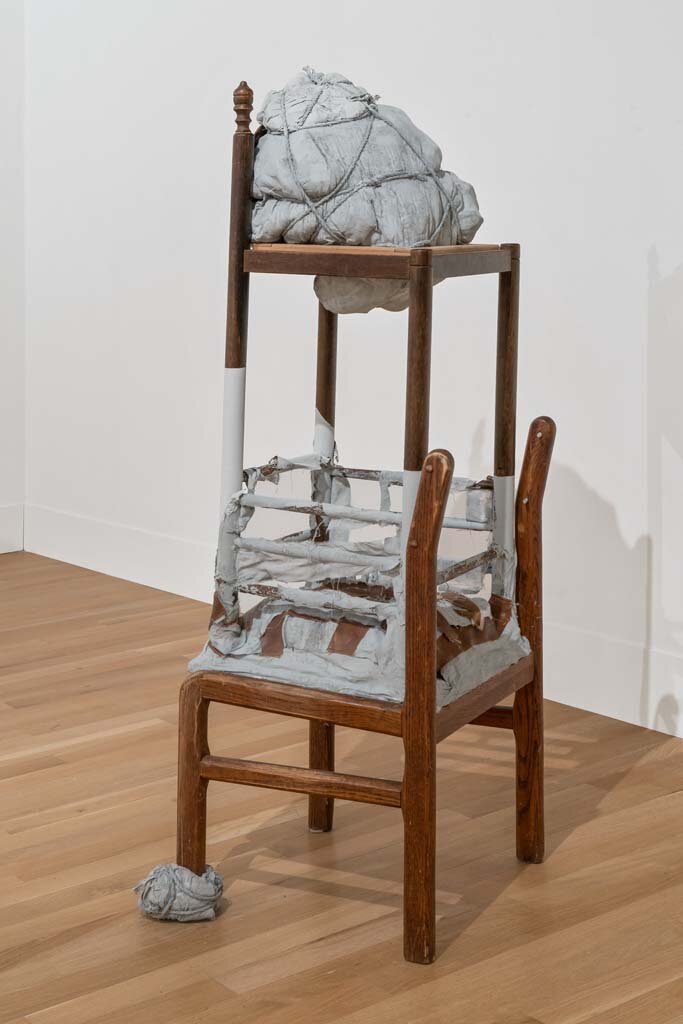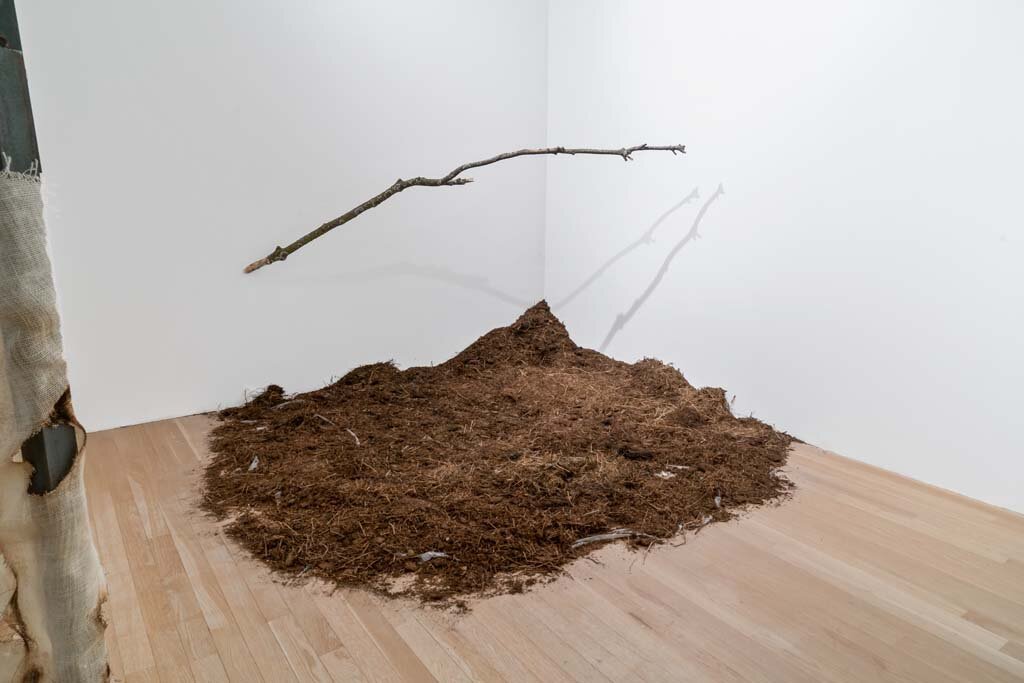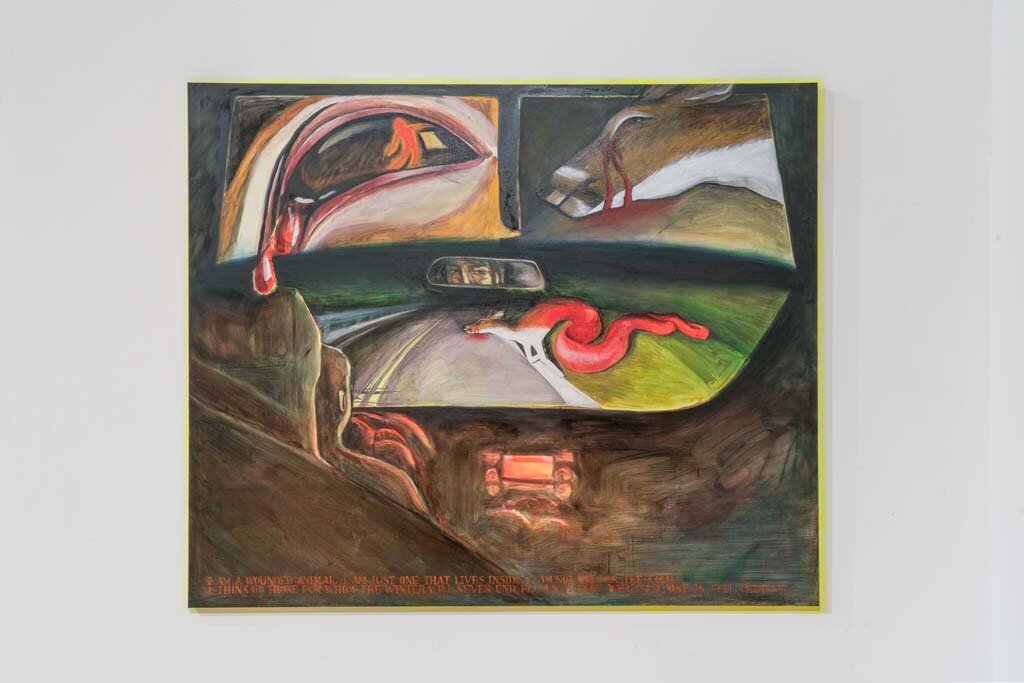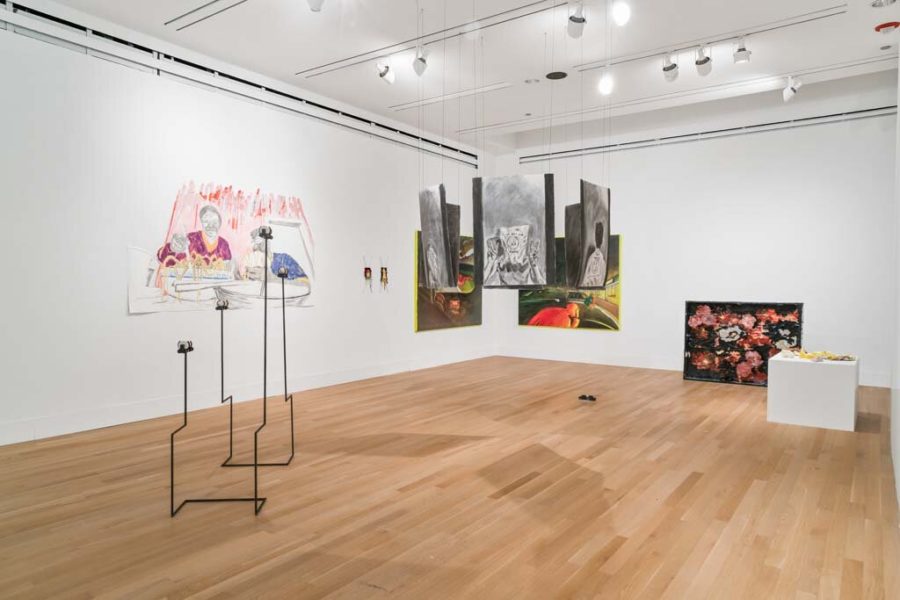Open until May 9 at the Reva and David Logan Center for the Arts, the 2021 BA Thesis Exhibition presents work produced by 11 student artists during an unprecedented year in arts pedagogy. youre muted showcases pieces ranging from sculptural to digital media by Ana Liu, Andrea Grant, Ashanti Owusu-Brafi, Evelyn Shi, Everett Black, Hurston Wallace, Jessica Vanahill, Jonathan WuWong, Maggie Hart, Martin Girardi, and Yolanda Dong.
Though it was scheduled to welcome the public on Friday, April 9, the exhibition opening was postponed due to the University’s stay-at-home order in response to a frat and travel-induced outbreak of COVID-19 cases on campus. Thankfully, the exhibition has not met the same fate as last year’s cancelled BA and MFA Thesis shows. As such, even with ample online documentation, viewers are still afforded the invaluable opportunity to see the work in the flesh.
Yet, youre muted does not put on any airs of pre-COVID normalcy: the very title, accompanied by a distorted, glitched-out promotional graphic, speaks to its conception and reception during a time that is highly mediated by remote technologies like Zoom. In speaking with a few of the exhibiting artists, it was clear just how much the experience of working through the last year of the Visual Arts major was impacted by the pandemic, even with some lucky allowances. Unlike previous generations, the Class of 2021 artists could not share studio space and work together. According to some, the loneliness of asynchronous viewings and the awkwardness of virtual critiques made for some frustrating experiences and often dramatically different perceptions of the art. Naturally, this is also true of the exhibition they have diligently installed. Despite this, and the likely reduced number of in-person viewings, the exhibition does include a myriad of works that reward close looking in person.

Margaret Hart’s assemblages, for one, combine found objects and hardware store media to generate highly affecting and tactile experiences. Perhaps similarly to the way the Zoom tile came as a head-splitting, eyeball-drying perversion of the window, Replevin offers viewers a window frame that is mutating and corrupting. (However, this might be reading too much into the work through COVID-tinted sunglasses). Hart’s other sculptures also take objects that constitute the home, such as chairs and tables, and “disembowel” them, to borrow a word from the artist, upsetting their functionality within domestic space. In Scab-picker, a thin, shaky skeleton resists the weight of several oozing stalactites dripping downward, as if to close a wound never left at peace. Directly referencing the University’s Student Disability Services homepage, Appropriate reasonable accommodations reifies the learning difficulties experienced within a structure built to cater to neurotypicality.
Somewhat similarly to Hart’s work, Martin Girardi’s sculptures are “deliberately up to interpretation,” in the latter’s words. The pieces occupy the other side of the gallery space and include photographs, ceramics, some welded metal pieces, and wood—but also light, moving image, and sound. Walking by burst, a viewer may notice the slight hint of motion from the corner of their eye as forms flicker, slide, and slither across the painted plaster and plywood sculpture. Perhaps less subtly, in sheep’s clothing commands its corner of the room just feet away. A wooden spear shoots out the ground through four sheep heads, which stare sideways at the viewer, some of them crying tears of blood, all their mouths agape. Periodically, the main gallery swells with a high-pitched, whirring sound from Girardi’s untitled video work. Combining claymation with high frame rate footage, the video depicts various insects and flowers crawling out of a ski mask while mysterious ceremonials take place in the background.

Moving on, ashanti Owusu-Brafi’s installations function as a kind of “sculptural collage,” to use the artist’s own words, in which found objects are combined, sculpted, and crafted into evocative composites. The piece Trust Totem (Generational Trauma Without the Ancestral Knowledge) features a horse skull vacuum-formed in plastic, made as if to hover over some canvas and several half-hidden vials of blood. The work draws from inherited object-crafting practices and contemplates indigeneity and lineages. However, the land is not merely indexed by the artist’s work through bone and blood: the brown earth literally infiltrates the pristine space of the art gallery in Broadside, which consists of a stretch of horse manure occupying a corner.
Ana Liu’s work, by contrast, veers away from these distinct sculptural practices: the 3-dimensionality of the object in space is collapsed to the illusionistic plane of the canvas or weaving, and a very tactile abstraction is supplanted with deeply contrived symbols. The eternal play of light and darkness is re-enacted in Liu’s work. The cosmic melodrama is recast in the streetlights and shadows of the American suburban night. The artist’s diptych of paintings is done in oil on canvases primed with neon yellow instead of the conventional white, which is why something always seemed to secretly scintillate even from within the nocturnal scenes. In Slushie, a parking lot sky is awash with night as a glowing, antlered figure sips or slurps on the eponymous nectar. In Deersnake a chimera lies wounded on the roadside, illuminated by a damning pair of headlights. We are both inside the car, seemingly about to run it over, but also crouching low beside it, staring deep into the prophecy of its dying eyes. Playing with an archetypal palette, Liu taps into deep-seated ideas and feelings of loneliness, humiliation, safety, refuge, danger, goodness, and evil.

Working through the intricate politics of portraiture, especially self-portraiture, Andrea Grant “find[s] comfort in what it means to hold hurt and to create with it.” The artist’s drawings and paintings explore ideas of beauty, self-love, and the body. A bedroom brims with blooming flowers and fungi in IM SORRY IM JUST FEELING A LITTLE LOST, its protagonists seeming languidly bored. Meanwhile, in it hurts more when you don’t say anything a figure glances downwards in grayscale anguish while a background of light, peach tones ripple behind them. In Reposada, on the other hand, the figure is an abstract slurry of coral pinks, sky blues, and glittering gold leaf, as well as a host of other halcyon shades of rest. Grant also offers visitors a Spotify playlist they can listen to while viewing the works on display, creating more immersive atmospheres around them.
Another artist probing the self-portrait as a meditation on identity is Jonathan WuWong, whose drawings and painting explore themes of intimacy, self, family, privacy, and the public. The artist’s work includes six charcoal drawings suspended from the ceiling in a ring that the viewer must orbit to view. Gently swaying in the air, the drawings form a mobile sculpture that sections off a small piece of the gallery into its interior, leaving the viewer to explore the images on its exterior. Each paper panel features a representation of the artist in a different pose with the plastic “Thank you/Have a nice day” bag, which is worn as cape, as scarf, as mask, and which adorns, conceals, and suffocates. The smiley face on the diaphanous plastic is upturned, shrunken, distorted, or replaced by the ghostly impression of the artist’s own face. Drawing on themes of acceptability and palatability by taking the ‘classic’ Chinese takeout bag as an object of focus, the artist interrogates the difficulties Chinese Americans face while navigating the United States.
Influenced by ecocritical thought, Everett Black makes work that thinks through human and non-human ecologies, as well as the ways we relate to the environment. The collection of glazed, biomorphic porcelains in These Mean Very Little to Me evokes natural forms like coyote skulls and, perhaps, creatures of the deep sea. Located outside the gallery in the Gidwitz Lobby, From the Ground Up (fuel) features large sticks mummified in dark, crinkly, slightly reflective plastics.
The smaller side gallery, meanwhile, houses the video works of Hurston Mazard Wallace and Evelyn Shi, which are projected in large-scale on the wall. The former’s work consists of a series of original animations, edited cartoons, and joke commercials that combine to create the TV channel Nostalgia Toons. Among these are some old Scooby Doo episodes that are revamped into “Scooby Dub” with Mazard Wallace and some collaborators’ voices. Another segment features as its host “the demon with literally no sense to have a sense of human decency” who takes the viewer through an apocalyptic landscape rife with hilarious disasters. Besides parodying a well-known cartoon, the artist manufactures nostalgia by skillfully employing popular cartoon tropes and sound effects.
In spite of the vast rift between viewing art online and looking at it in person, the work on display at this year’s BA Thesis Exhibition offers compelling and thought-provoking experiences regardless of the viewer’s location.









